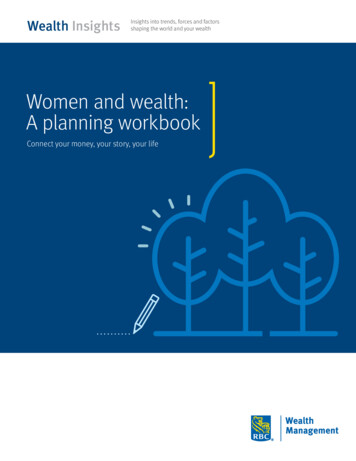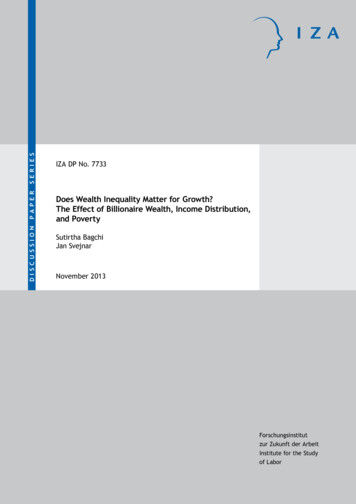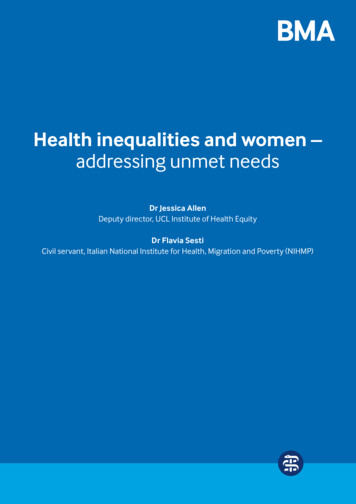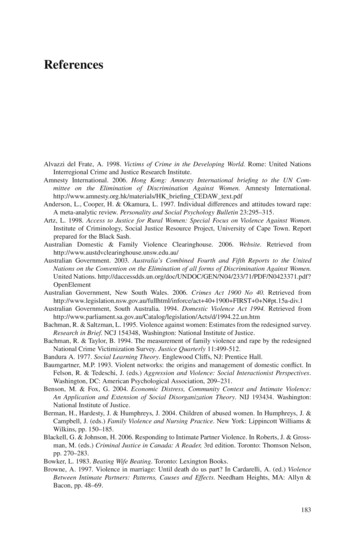
Transcription
Wealth InsightsInsights into trends, forces and factorsshaping the world and your wealthWomen and wealth:A planning workbookConnect your money, your story, your life
Page 2 of 28 Women and wealth: A planning workbookA workbookfor youWomen have emerged as an economic powerhouse—earning,controlling and inheriting more wealth than ever before.Research shows women in the United States now control 52%of wealth, which is expected to continue to grow to an estimatedtwo-thirds by 2030. With this wealth comes more financialresponsibility and complexity, often intertwined with jugglingcareers, caregiving and life’s transitions.This workbook is a practical guide to help you thinkcomprehensively about your financial health and identifyactionable steps you can take to build more confidencein your plans for tomorrow. In these pages, you’ll find strategiesdesigned to help you grow, manage and protect your wealth.We’ve also included several practical worksheets you can useto create your own financial story:5 Worksheet 1:What is your personal money story?9 Worksheet 2:Understand your starting point11 Worksheet 3:Create your 50/30/20 spending plan15 Worksheet 4:Estimate retirement expenses25 Worksheet 5:Your heartfelt legacyInvestment and insurance products offered through RBC Wealth Management are not insured by the FDIC or any other federalgovernment agency, are not deposits or other obligations of, or guaranteed by, a bank or any bank affiliate, and are subject toinvestment risks, including possible loss of the principal amount invested.
Page 3 of 28 Women and wealth: A planning workbookEnsuring the financialempowerment of womenWhether they’re buildinga career, working inside thehome, partnered, married,divorced, widowed or solo,it’s important for womento take an active rolein their financial lives.Women reach new heightsWhether by choice or by circumstance, women areincreasingly in roles where they must be responsible fortheir long-term financial security. In fact, the vast majorityof women will be in charge of their family finances atsome point in their lives by choosing to remain single,experiencing divorce or simply living longer than men.Women face unique challenges that underscore the needfor financial planning. Women have a longer average lifespan and may need to planfor longer retirements and greater health care expenses. While women have high expectations for their careers and financial lives,a lack of financial confidence can undermine their financial plan. When it comes to managing investments, only 52% of women say theyare confident compared to 68% of men—even when they post the samefinancial literacy scores.1 Women recognize the need for more financial help, yet often failto make it a priority in their busy lives.Financial security begins with a plan.A financial advisor you trust, and a plan that you create together, can helpyou accomplish your financial priorities—and move toward your visionof the future with confidence.At RBC Wealth Management,we are committed todelivering insights thateducate, equip and engageyou on your financial journey.
Page 4 of 28 Women and wealth: A planning workbookKnow your money mindsetMoney plays into all aspects of a person’s life. It is woven into thefabric of your relationships, dreams, fears, successes, failures andstruggles. How you feel about money is shaped by your personalexperiences and by those who have influenced you in life: parents,grandparents, spouse, friends, teachers and more.Money reverenceThese individuals areconvinced that more moneywill solve all of their problemsand that money brings powerand happiness.Money avoidancePeople with this trait believethat money is bad, that wealthypeople are greedy and that theydon’t deserve money.Create your ownmoney mantraIdentify yourmoney scriptAccording to financialpsychologist Dr. BradKlontz, we develop oneof four main “money scripts,”or money personalitiesthat drive financial behaviorthroughout our lives.Which money script doyou most identify with?Money statusThese individuals believethat owning the newest andbest things confers status.Money vigilancePeople with this trait embracefrugality, are committed to savingand are discreet about howmuch they have or make.A money mantra is a personal motto you can repeat over and overagain to help create new, healthier money scripts. It’s a powerful wayto remind yourself to make better financial choices at every opportunity.
Page 5 of 28 Women and wealth: A planning workbookWhat is your personalmoney story?Worksheet 1Think through your history, influences and experiencesthat have formed your personal relationship with money.My influencesMy scriptsWho has been most influential in your financial journey and why?What are some of your consciousand unconscious beliefs about money?How would you change them?Today:My memoriesWhat are some of your earliest memories of money?Tomorrow:Positive:Negative:
Page 6 of 28 Women and wealth: A planning workbookSpecial considerationsWhile women are rewriting their stories in their30s, 40s, 50s and beyond, they face unique financialcircumstances that require special considerationin the financial planning process. Women take on a multitude of rolesover their lifetime. Women are leadingFortune 500 companies, winning toppolitical posts, owning successfulbusinesses and enjoying more careerchoices than ever before. At the sametime, many women find their role athome equally demanding as theytake on parenting, caretaking andvolunteering while juggling householdresponsibilities.Partner/spouseWomen are waiting longer to getmarried, accumulating their ownwealth and developing financialindependence. As financial householdstie the knot, it is important to discusshow your wealth will be integratedand managed and how financialdecisions will be made. Subsequentmarriages and the blending of familiescome with additional complexity.Understanding the demands on yourtime and the financial implicationsof life’s transitions will help you focuson what is most important and betterprepare you for the unexpected. BreadwinnerWomen are more educated, earningmore and increasingly are the sole orprimary breadwinner. Also, the amountof women who earn more than theirhusbands continues to grow. As yourcareer and earnings grow, maintaining ahealthy life-wealth balance is important.What roles do you play? Checkall the boxes on these pages thatapply to your situation.Changing demographics have reshaped the American family.Today, the majority of households fall into the nontraditional categoryand have a unique set of circumstances that require tailored advice. SOLO LIVINGNearly 30 percent of Americanhouseholds are now headedby single adults.2 Single adults,whether by choice or throughthe death or divorce of a spouseor partner, have one thing incommon: the fallback positionor safety net of a second incomeis often nonexistent. BLENDED FAMILIESBlended families representthe largest number of nontraditionalhouseholds. Along with children,remarried spouses typically bringfinancial responsibilities frompast relationships. Learning howto manage multiple financialresponsibilities from previousrelationships is the key tofamily harmony. SAME-SEX HOUSEHOLDSMarriage equality has simplifiedfinances, giving same-sex couplesthe ability to file joint tax returns,list partners on health insuranceand ensure a spouse’s interestsare protected in the event of death.But many laws affecting same-sexcouples are state-specific, so when itcomes to finances, it’s wise to workwith professionals who specialize inestate planning for same-sex couples.
Page 7 of 28 Women and wealth: A planning workbookCaregiving is a selfless act that takes a mental, physical and emotionaltoll. The majority of caregivers are women, and on average they spend 7,000 annually in out-of-pocket expenses in addition to havingto take time off from their jobs to care for a family member.3 CaregiverWomen still take on the majorityof the family caregiving, whichoften extends into caring for agingparents while still supporting youngadult children. That further impactsa woman’s career and finances. ParentMULTIGENERATIONAL FAMILIESMore generations are livingtogether in the same householdthan ever before. Multigenerationalplanning brings its own challenges.Multigenerational families’ needs arevast and varied, but to avoid conflictover who pays for what, it’s essentialfor households with multiple adultgenerations to talk frankly aboutshared financial responsibilities andto communicate openly about money.Business ownerWomen are enjoying great success asentrepreneurs and business owners.Along with the allure of independenceand flexibility comes additionalfinancial complexity. Thinking throughthe role that your business plays inachieving your lifestyle and long-termgoals is an important step. Kids are expensive and time-consuming.On average, you can expect to spendnearly 250,000 on raising a childthrough age 17, and that does notinclude the escalating cost of college.Stay-at-home moms are especiallyimpacted. Raising children continuesto contribute to career gaps for womenthat can result in lower retirementsaving and Social Security benefits. Household executiveWhile household executive powerhas balanced out some, studies showthat working women continue toperform the majority of householdand child care responsibilities. Busycouples tend to divide and conquer,with financial responsibilities oftendivided or relinquished to one spouse.It is important to be an activeparticipant in your financial life. DIVORCEDOverall divorce rates are down,but gray divorce (age 50 ) is at anall-time high, according to multiplestudies. Navigating the emotionaland financial implications ofdivorce is challenging at best, withadditional complexity as you ageand your wealth grows. WIDOWEDWomen statistically live longer andare much more likely to be widowed;age 59 is the median age of whena woman loses her spouse.4 Havinga financial plan in place can providepeace of mind during a difficult time.
Page 8 of 28 Women and wealth: A planning workbookLife planningReaching your destination requires a comprehensiveapproach to your financial life. It is important to beproactive about your long-term wellbeing, no matteryour age or wealth.At RBC Wealth Management, we believe financialwellness requires a wealth plan that always addresseseach of these key financial pillars:Your focus in this workbookwill depend on your life stage.We address these life stages as: Working toward tomorrow Approaching retirement Thriving in your encore yearsAccumulateand grow yourwealthFrom having an emergency fund to developing various ways to savefor the future, it’s important to focus on achieving long-term wealth.As you step through life’s stages, there will be opportunities toaccelerate wealth building through events such as home ownership,inheritance, liquidation events and income spikes.Fund yourlifestyle todayand tomorrowHow you think about spending needs today versus in the future playsinto lifestyle choices. Planning ahead to ensure your essential needsare covered is a top priority. This requires a view into the futureand an understanding of the impact of the market, inflation, taxes,interest rates and other risks that might impact your plan, and howthe impact changes as you age.Protect whatis importantto youProtecting your family and your wealth during your working years isfoundational to sustaining wealth. As you age and your wealth grows,it is important to revisit the purpose and amount of coverage for yourprotection strategies, as well as explore other important considerations,including protecting your wealth for the next generation.Create alasting legacyTackling estate essentials is an important step that everyoneshould prioritize, regardless of age or wealth. Establishing key estatedocuments, including a current health care directive, will, and powerof attorney, are important first steps. Ensuring your assets are properlytitled and beneficiary designations are current are a vital part of anybasic estate plan.
Page 9 of 28 Women and wealth: A planning workbookUnderstand your starting pointAs you start to plan, begin with your expectations for your future,layer in your concerns and then prioritize your goals.Worksheet 2My expectationsMy goalsWhat expectations do you have for your future as you visualize it today?Goals can be categorizedas needs, wants and wishes. Active lifestyle Work by choice Quiet lifestyle Time to travel Opportunity to help others Caregiving Financial freedom Retirement Second career Needs Health care Funding your lifestyle Home repair Wants CollegeMy concerns New carWhat concerns do you have as you think about your future plans? Travel Not having a paycheck Dying early Running out of money Living too long Suffering investment losses Wishes Health care or long-term Start a business Major purchasecare costs Gift or donation Be specific about your expectations, concerns and goals.Also, you may wish to add dates to your goals.
Page 10 of 28 Women and wealth: A planning workbookTake ActionEstablishing yourspending plan Be flexibleSpending plans thatare too rigid often fail.Do you wonder where your money goes each month?Does it seem like you’re never able to get ahead? If so, youmay want to establish a spending plan to track how you spendyour money— and to help you reach your financial goals. Stay disciplinedCommit to making budgetinga part of your daily routine. Involve the entire familyAgree on a spending planand meet regularly to monitoryour progress.1. Examine your financial goalsBefore you create a spending plan, examine your financial goalson the previous page. Start by making a list of your short-termgoals (new car or a vacation) and your long-term goals (saving foryour child’s college education or retirement). Next, ask yourself: Howimportant is it for me to achieve this goal? How much will I need tosave? Armed with a clear picture of your goals, you can work towardestablishing a spending plan that can help you reach them.2.Identify yourcurrent monthlyincome andexpensesTo develop abudget that isappropriate foryour lifestyle,you’ll needto track yourcurrent monthlyincome, savingsand spending.First, add up all of your income.In addition to your salary andwages, include any other sourceof income, such as dividends,interest or child support. Next,add up your expenses. To seewhere you have a choice in yourspending, it helps to divide theminto two categories: fixed expenses,including housing, food, clothing,taxes and transportation, anddiscretionary expenses, such asentertainment, vacations andhobbies. To make sure that you’renot forgetting about any out-ofpattern expenses, look throughyour canceled checks, credit cardbills and other receipts fromthe past year.3.Evaluate yourspending planOnce you’ve added up allof your income and expenses,compare the two totals.If you spend less than you earn,you’re on the right track. Butif you find yourself spendingmore than you earn, you’ll needto make some adjustments.Review your expenses and cutdown on discretionary spending.With determination and selfdiscipline, you’ll eventuallyfind the right balance betweenspending and saving.4. Monitor your planYou’ll need to monitor your budget periodicallyand make changes when necessary. You needn’ttrack every penny that you spend; the less recordkeeping you have to do, the easier it will be to stickto your budget.
Page 11 of 28 Women and wealth: A planning workbookCreate your 50/30/20spending planWorksheet 3A strategy to help you plan for must-haves, wants,and savings or emergency funds.Start50%Your total monthly incomeafter taxes, deductionsand contributions to yourretirement and healthsavings plansAmount you shouldspend on must-haves(monthly income x .5)Amount you shouldspend on wants(monthly income x .3)Amount you have left todevote to savings/debt(monthly income x .2) To get started, simplyadd up your total household income, including:The biggest piece—the50% piece—goes towardall of your basic necessities. This is must-havestuff, including:The 30% piece goestoward all the extras—“wants” that are nice,but not essential: Your income(after taxes)Your spouse orpartner’s income(after taxes)Any other sourcesof income, like childsupport or alimony30%20% Cable TV VacationsThe 20% that’s leftover goes to you inyour savings account oremergency fund. You canalso use it to make anextra payment on a creditcard or student loan or to: Dining out Add money to anemergency fundNon-essentialclothing purchases Groceries Increase yourretirement savingsHobbiesChild care/tuition MagazinesMake extra paymentson must-have items Internet and mobile Music and moviesubscriptionsSave for a majorpurchase or adventureMinimum creditcard payment(s) Gym memberships Student loanpayment(s) Car payment(s) Taxes Rent/mortgagepayments/utilities Insurance Transportationexpenses
Page 12 of 28 Women and wealth: A planning workbookBased on the Fair Credit Reporting Act, you can request a free copy ofyour credit report every 12 months at AnnualCreditReport.com, or call(877) 322-8228. Check your report to make sure that the informationis correct, that no one is fraudulently listed on your report and that allaccounts listed are actually yours, since mistakes can happen.Take Action Do you always pay yourbills on time? Not just creditcard bills but all loans, rent,utilities, etc? Do you apply for andopen new credit accountsonly as needed?Unnecessary credit canharm your credit score, fromcreating too many inquirieson your credit report totempting you to overspend.Know your scoreYour credit score is one of the most important aspectsof your financial life. Good credit scores can unlockmany savings and benefits, including access to loansand credit cards with the most favorable terms. Do you know your creditscore? Request a copy ofyour credit report and disputeany errors on it—even thesmall ones.Understand how your credit score is determinedYour credit score reflects your payment history on loans and credit cards, howmuch revolving credit you regularly use, how long you’ve had accounts open,the types of accounts you have and how often you apply for new credit.Most credit scores fall between 600 and 750; scores above 800 are consideredexcellent. And while the major credit agencies each report informationdifferently, all reports contain your Social Security number, date of birthand employment information.Amount owedHow much do youowe on each account,and how muchof your credit limithave you used?30%35%Payment historyHave you paid yourbills on time? And ifnot, how late wereyou, when were youlate and how often?10%Types of creditWhat kind of debtsdo you have?10%15%Credit historyHow long have youhad each account?New creditHow many credit requests haveyou made and how many reportshave been pulled on you?Rock-solid pieces offinancial advice thateveryone should striveto follow:Save money for an emergencyfund. Pay down your debt. Don’tspend more than can you afford.And strive to keep your creditscores as high as possible.Keep in mind that loans canactually help you build wealththrough events like purchasinga home (and benefiting fromrising property values) or startinga business.
Page 13 of 28 Women and wealth: A planning workbookTake Action Do you know yourretirement numbers?Take time to set a goaland monitor your progress. Have you started to savefor retirement? Look atmaxing out your employerretirement plans andtake advantage of youremployer’s 401(k) matchingcontributions.Strategic savingSaving and investing for long-term goals like retirementmay seem daunting. Yet by taking a systematic approachand following several best practices, your retirementsavings can grow strategically over time.It’s important to start saving early, since compound interest can makea dramatic difference over time. Compound interest is not only calculatedon the initial principal of your retirement savings account, but also on theaccumulated interest of prior periods.In this illustration, the early investor will reach a balance of 1 million byage 65 while the late investor will retire with approximately 840,000.*Amount contributedBalance at age 65Your friendsaves fromage 35 to 65If you are over age 50,you can take advantage ofcatch-up contributions inyour tax-advantagedaccounts, such as your401(k), IRAs and HealthSavings Account, to boostyour savings. Are your assets diversified?Use the power of compound interestYou save fromage 25 to 40 Are you age 50 or older? 150,000 1,058,912 300,000 838,019*A 10,000 annual investment made by a 25-year-old for 15 years versus a 10,000 annual investmentmade by a 35-year-old for 30 years. This hypothetical illustration assumes an annual 6% return.Asset allocation—the wayyou divide your portfolioamong asset classes—isthe first thing you shouldconsider when getting readyto purchase investments,because it has the biggesteffect on the way yourportfolio will act. Have you considered thebenefits of a Roth IRA or401(k)? Traditional IRAcontributions are taxdeductible for the year youmake the contribution, withwithdrawals in retirementtaxed at ordinary income taxrates. In contrast, a Roth IRAprovides no tax break forcontributions, but earningsand withdrawals are tax-free.
Page 14 of 28 Women and wealth: A planning workbookTake ActionHow much do you need to save forretirement? It’s one of the most commonquestions people have. Are you saving enough?Saving 15% of your incomeannually can put you ontrack to meet importantfinancial milestones. Is your retirement dateflexible? The longer youwork, the more your savingscan grow.Milestone savingThe age you plan to retire will have a big impact on theamount you need to save, and your milestones along theway. Don’t be discouraged if you aren’t at your nearestmilestone—there are ways to catch up through planning andsaving. The key is to take action, and the earlier the better.Save “x” your starting salaryThe following age-based savings factors can help you plan, and save enough tomaintain your lifestyle in retirement. To help you stay on track, we suggest theseage-based milestones: Aim to have at least 1x your annual income saved by age 30,3x by 40, 6x by 50, and 8x by 60.10xAnnual salaryAverage savings 1M8xRecommended savings 800K 400K1x 200KAge:20 yrs30 yrs72 10 7.2 yearsTry this equation using yourinvestment’s interest rate.Note that this equation alsoworks for inflation.3x40 yrs50 yrsThe rule of 72 is a simple equationto determine approximately howlong it will take for an investmentto double in value given a fixedinterest rate. Just divide 72 byyour interest rate.For example: If you invest moneyat a 10% return, you will doubleyour money every 7.2 years.6x 600KThe rule of 72: The powerof compound interest60 yrs67 yrs
Page 15 of 28 Women and wealth: A planning workbookEstimate retirement expensesCalculate the total savings you may need to coveryour expenses in retirement.Worksheet 4Estimate how much you may need to save:Fill in your answers:A.A. Enter your current annual household income in Box A.B. Review Table 1 and select the number of years until your retirement. Next, selectthe percentage you estimate that your annual income will increase and find thefactor associated with these two numbers. Multiply Box A by this factor and writeyour answer in Box B.(As an example: 100,000)B.C. Typically, retirees spend 70–80% of pre-retirement income to maintain theirstandard of living. Multiply Box B by 0.75 and write the answer in Box C.Your projected annual salaryjust prior to retirement. See Table 1.( 100,000 x 2.67 267,000)D. Review Table 2 and select how many years you anticipate living in retirement.Next, choose the percentage that best reflects your anticipated return on investmentsduring retirement. Multiply this factor by Box C and write the answer in Box D.E. Typically, Social Security benefits fund 30–40% of retirement income. The other60–70% of income will need to come from retirement savings. Multiply Box Dby 0.60* and write the answer in Box E.Estimated income you will needannually during your retirement tomaintain your current standard of living.( 267,000 x 0.75 200,250)Table 2Anticipated increasein income, annuallyAnticipated return on investmentsduring 57.69402.214.8010.29452.445.8413.77Years in retirementYears to retirementTable 1C.Experts say that a man who is 65 years old todayhas a life expectancy of 18 years, while a womanof the same age can expect to live about 20 moreyears. These averages are expected to increase.The Department of Labor assumes anincome growth rate of 3.80% as of 2013.To base your growth factor on approximatelythis rate, choose a factor in the 4% column.D.Estimated total amount you will needto fund your retirement. See Table 2.( 200,250 x 10.6748 2,137,629)E.Estimated total amount you may needto fund your retirement income (doesnot include Social Security benefit).( 2,137,629 X 0.60 1,282,577)*You may want to calculate yourtotal using different assumptionsand compare the results.
Page 16 of 28 Women and wealth: A planning workbookTake ActionDon’t let market volatilitydistract from your goals. Are you investing forthe long haul? Time inthe market is a much betterstrategy than trying to timethe market. Do you have a readycredit line? Obtain a creditline to help cover unexpectedneeds and to avoid havingto sell during down markets.Managing the risk in your plan Do you react to marketvolatility? Only reactto market movementsin the context of yourfinancial plan and long-terminvestment goals.Over the long haul, stocks historically provide attractivewealth-building opportunities. But in the short term,stocks can be volatile, causing some investors to makeemotional decisions that undermine their investment strategy.That’s why it’s important to have a financial plan thatcan guide you through gyrations and keep you focusedon your long-term goals. Do you have a wealth plan?A plan can help tune outthe noise and keep youfocused on your goals inany environment.Life comes with riskWhile markets can rise and dip, you may help weather market volatilitythrough a diversified portfolio and by taking a long-term view. The followinggraph represents the growth of a hypothetical 100,000 investment in theS&P index over the last 20 years (1995–2018).Euphoric edPanic-StrickenPanic-Stricken12/9512/00Source: BlackRock; Informa Investment Solutions 201612/0512/1012/1512/18
Page 17 of 28 Women and wealth: A planning workbookAccording to the U.S. Department of Health and Human Services,one-third of all women who become widowed are younger than age 60,and half of those widowed become so by age 65. In fact, 7 out of 10female baby boomers can expect to outlive their husbands.Take Action Do you have insightsinto your life expectancy?Use your health history,including your gender, familyand lifestyle, to informprojected life expectancy. Does anyone rely on yourPlanning for the unexpectedWhat if something happened to you or your partner?What impact would that have on your financial well-being?Life insurance is foundational to financial health andwell-being. Your ability to contribute to your financial goalsand protect your family is vital. It is important to have aprotection strategy that is appropriate for today and flexibleenough to change over time.As you move through life, it’s important to have a protection strategy thatreflects your current situation, yet is flexible enough to change over time.Entering theworkforceCareerand familyAs you advance in yourcareer and build a family,it’s important to have enoughinsurance to cover the balanceof your mortgage and maintainyour family’s current lifestyle. Have you considered theneeds of your spouse,partner, children and otherdependents? Model multiplescenarios, and include asurvivor plan that addressesthe needs of all dependents. Could you pay the billsLife moves through stagesWhen you’re starting out,life insurance can keep yourloved ones from having to tacklelarge financial issues when theymay be least equipped to do so.income for their financialwellbeing? If you answeredyes, you probably needlife insurance. If you’rea business owner, lifeinsurance can sustainyour business shouldsomething happen to youor a business partner.Near the homestretch,life insurance can safeguard anyremaining mortgage on your home,provide income to assist parentsor in-laws, finance health care costsor arrange for ongoing care for special needs situations.Caring for family,aging parentsRetirementand legacyRetirement is a time to berewarded for your planning andhard work. Protection solutionscan provide for ongoing cash flowretirement needs, pay off anyremaining debts and leave a legacy.if you’re out of work?Disability insurance can helpsupport your current standardof living if you’re out of workdue to a health issue.Four types of coverageeveryone should consider,in addition to life insurance: Health: Young and healthy peopleshould consider high deductibleplans and a Health Savings Account. Property and casualty: Coversyour car, home and belongings.Umbrella insurance is importantas your wealth grows. Disability: Replaces your incomeif you are disabled or can no longerwork at your job. Long-term care: Helps cover thecost of care if you have a chronicmedical condition or a disorderlike Alzheimer’s disease.
Page 18 of 28 Women and wealth: A planning workbookTake ActionWomen live5 yearslonger than menon average 5Women make up70%of nursing homeresidents 6Women are Have you planned ahead—80%especially when there’sfamily history of longevity?Have key legal d
Page 6 of 28 Women and wealth: A planning workbook While women are rewriting their stories in their 30s, 40s, 50s and beyond, they face unique financial circumstances that require special consideration in the financial planning process. Special considerations Women take on a multitude of roles over their lifetime. Women are leading










